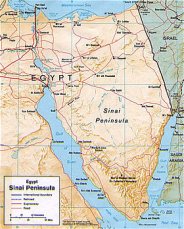A month to the Palmer Report on the Gaza flotilla

Eyal Clyne on the spinning of “the blockade on Gaza is legal”
The release of the report of the UN-appointed Palmer Panel a month ago was nothing less than a source of pride for Israeli speakers, who repeatedly emphasised its ruling that the naval blockade on Ga
Eyal Clyne is an Israeli researcher of society in Israel-Palestine. He focuses on the conflict and other Israeli political issues. Some of the posts on his Hebrew blog appear also in English and elsewhere, and some of his pieces for JNews are also cross-posted with other sites.
This article may be reproduced on condition that JNews is cited as its source


 This work is licensed under a Creative Commons Attribution-Noncommercial-Share Alike 3.0 Unported License.
This work is licensed under a Creative Commons Attribution-Noncommercial-Share Alike 3.0 Unported License.
Interim analysis - Israel and Gaza; Sinai and Egypt

As Egypt tries to broker a ceasefire between Israel, Hamas and armed groups in Gaza, JNews takes a look at implications for the players
Interim Analysis
Key points
This article may be reproduced on condition that JNews is cited as its source
 This work is licensed under a Creative Commons Attribution-Noncommercial-Share Alike 3.0 Unported License.
This work is licensed under a Creative Commons Attribution-Noncommercial-Share Alike 3.0 Unported License.
Egypt withdraws ambassador from Israel over officers' deaths

Death toll in Gaza up to 15 as Israeli air-force strikes civilian targets, militants. AlQassam Brigades announces ‘end to truce’; PRC denies involvement in Eilat attacks.
Egypt has declared its decision to recall its ambassador to Israel following the killing of several Central Security Force officers near the Egypt-Israel border on Thursday.
This article may be reproduced on condition that JNews is cited as its source
Image from Wikipedia

 This work is licensed under a Creative Commons Attribution-Noncommercial-Share Alike 3.0 Unported License.
This work is licensed under a Creative Commons Attribution-Noncommercial-Share Alike 3.0 Unported License.
The flotilla and the siege – resistance and complicity

While the second flotilla to Gaza prepared to set sail this week under the motto ‘Stay Human,’ Europe moved a step closer to full participation in the Israeli oppression of Palestinians
Despite widespread Greek support for the Palestinian cause, the Greek government bent to Miri Weingarten is an Israeli human rights activist and Director of JNews – Alternative Jewish Perspectives on Israel-Palestine.This piece is cross-posted on openDemocracy. This work is licensed under a Creative Commons Attribution-Noncommercial-Share Alike 3.0 Unported License.
This work is licensed under a Creative Commons Attribution-Noncommercial-Share Alike 3.0 Unported License.
Rafah Crossing restrictions to be eased over the weekend

Egypt’s transitional authorities announced on Thursday that they will ease conditions for entry of Palestinians from Gaza into Egypt via Rafah Crossing, as from Saturday 28 May.
See also:
http://www.haaretz.com/news/diplomacy-defense/european…
http://www.haaretz.com/print-edition/news/pa-consent-o…
This article may be reproduced on condition that JNews is cited as its source
Photo from www.alternativenews.org
 This work is licensed under a Creative Commons Attribution-Noncommercial-Share Alike 3.0 Unported License.
This work is licensed under a Creative Commons Attribution-Noncommercial-Share Alike 3.0 Unported License.
Member of the Jewish Boat to Gaza reaches Gaza
Eight months after the ‘Irene’ was raided by the Israeli navy, passenger Edith Lutz visits Gaza
On 14 May, eight months after the Jewish boat to Gaza was raided by the Israeli navy on its way to Gaza, one of its passengers arrived in Gaza.
This article may be reproduced on condition that JNews is cited as its source.
 This work is licensed under a Creative Commons Attribution-Noncommercial-Share Alike 3.0 Unported License.
This work is licensed under a Creative Commons Attribution-Noncommercial-Share Alike 3.0 Unported License.
The Middle East and North Africa – the end of the Cold War legacy?

As Israeli Prime Minister Netanyahu prepares for a visit to Washington to meet US President Obama, and US envoy to the Middle East George Mitchell announces a dramatic resignation, Glyn Secker examines the possibilities for the adoption of a new US policy in the Middle East.
US foreign policy in the Middle East dates from its post-WWII Cold War with the USSR over spheres of influence. Throughout the second half of the 20th century, Israel was central to this policy.
Glyn Secker is a member of Jews for Justice for Palestinians and was Captain of the Jewish Boat To Gaza, September 2010.
Photo by Vish Vishvanath.
This article may be reproduced on condition that JNews is cited as its source.
 This work is licensed under a Creative Commons Attribution-Noncommercial-Share Alike 3.0 Unported License.
This work is licensed under a Creative Commons Attribution-Noncommercial-Share Alike 3.0 Unported License.
The Middle East and North Africa – the end of the Cold War legacy?

As Israeli Prime Minister Netanyahu prepares for a visit to Washington to meet US President Obama, and US envoy to the Middle East George Mitchell announces a dramatic resignation, Glyn Secker examines the possibilities for the adoption of a new US policy in the Middle East.
Overview
US foreign policy in the Middle East dates from its post-WWII Cold War with the USSR over spheres of influence. Throughout the second half of the 20th century, Israel was central to this policy.
Glyn Secker is a member of Jews for Justice for Palestinians and was Captain of the Jewish Boat To Gaza, September 2010.
Photo by Vish Vishvanath/Metro.
This article may be reproduced on condition that JNews is cited as its source.
 This work is licensed under a Creative Commons Attribution-Noncommercial-Share Alike 3.0 Unported License.
This work is licensed under a Creative Commons Attribution-Noncommercial-Share Alike 3.0 Unported License.
Natural Gas: Egypt’s Subsidy of Israel

Mubarak’s regime in Egypt has been Israel’s most valuable ally in the region until recently.
Shir Hever is an Israeli economist and commentator who researches the economic aspects of the Israeli occupation of the Palestinian territories.
This article may be reproduced on condition that JNews is cited as its source.
 This work is licensed under a Creative Commons Attribution-Noncommercial-Share Alike 3.0 Unported License.
This work is licensed under a Creative Commons Attribution-Noncommercial-Share Alike 3.0 Unported License.




The Yesha Council Disengagement Plan
Next year in Gaza?
[i]
NOTES
“Yesha Council”, the umbrella organisation of Israeli ideological settlers, is one of the strongest organisations in Israeli politics. It is known for spreading hard-core right-wing ideology, and opposing any territorial compromise, using the council-taxes paid in the settlements. The name “Yesha” (literally: salvation) makes the initials for the Israelite-based region names of Judea, Samaria and Gaza, now constrained into denoting the modern West Bank and Gaza Strip.
[ii] “My Israel” is a group established by two of Netanyahu’s ex-staff members, and is supported by some of his donors.
[iii] The claim is not unreasonable. Given that the number of Jews and Arabs between the Jordan River and the sea at present is roughly equal, deducting approximately 1.5 million inhabitants of the Gaza Strip, results in a "Jewish majority" in the rest of pre-1948 Palestine. This will hold even if Israel continues to control the West Bank, or even annexes it.
[iv]The accurate numbers are always disputed and colored with visable political hues. Of the various surveys and countering surveys I can conclude that, to the best of my understanding, the numbers presented in the video are wrong. I would carefully estimate the numbers of Palestinians under Israeli rule in: about 1.6M inside the Green Line, and about 2.1M in the West Bank. This comes to about 3.7M Palestinians vs. 5.8M Jews (and others), not 3M vs. 6M, as shown in the clip. This is certainly not the important point to stress, but the truth must still be told to the Israelis who think it matters.
[v]It is interesting to note how enthusiastically they link the slow decrease in birth to the increase in women education (amongst Arabs), and even dare rule that the latter causes the former. However, at the same time, they completely skip the opposite invited conclusion, to connect the increase in birth of Israeli-Jews, to some possible implication we can assume it has, for instance, on the education, income and status of Jewish-Israeli women.
[vi] The data on Palestinian will to emigrate is also manipulated. In polls, respondents are rarely asked only Yes-or-No questions, but complex answers, such as “not overruling it”, “may have to”, etc. There are also in-depth questions, and different analyses, in addition to the fact that the formulation and timing of a question can dramatically influence the results. More worrying then these distortions, is the fact that the Palestinians who manage to leave tend to be the more pragmatic, educated, and wealthy, leaving behind a more poor, and less educated or pragmatic Palestinian society.
[vii]This is misleading both mathematically and in language. It is not argued that “Jewish-Israeli birth rate is higher than Palestinians’ birth rate”, but that “the gap between the two rates is diminishing”. In other words, the birth-rate of Arabs is still higher than the Jewish one, and it will take decades until they become equal (if the trends persist). The real question should have been what will happen first: that the two ratios will come to equivalence, or that there will be a non-Jewish majority, when following the absolute real numbers. You can make the calculations yourselves if you feel like it, but remember that this too ignores the possibilities of Arabs and Jews voting for the same parties, or in different participation rates, or of anything that may change the trends in such forecast.
The accompanying image is a screen-shot of a clip by the Yesha Council, addressing the Jewish public's “nightmares about the demographic demon” in a light-hearted manner.
Eyal Clyne is an Israeli researcher of society in Israel-Palestine. He focuses on the conflict and other Israeli political issues. Some of the posts on his Hebrew blog appear also in English and elsewhere, and some of his pieces for JNews are also cross-posted with other sites.
This piece is based on a post originally published in Hebrew and translated into English by Ofer Neiman.
This article may be reproduced on condition that JNews is cited as its source.